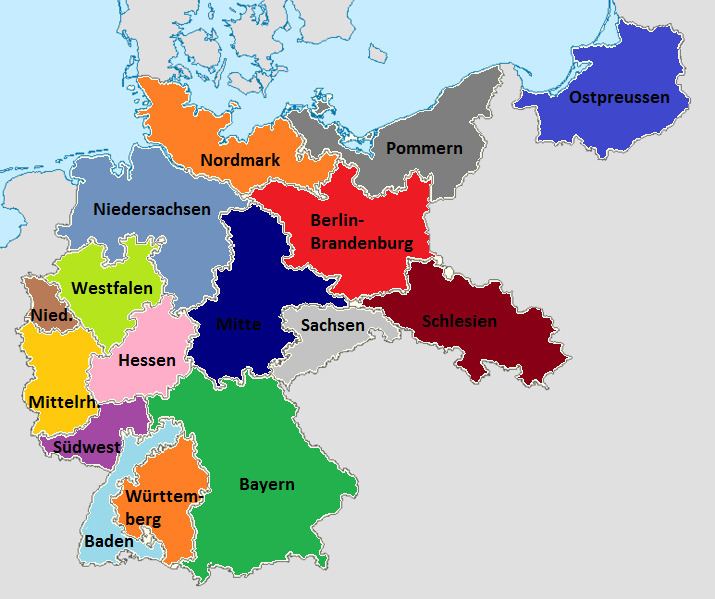Folded 1945 | Founded 1933 | |
 | ||
Provinces Province of Lower Silesia Province of Upper Silesia Autonomous Silesian Voivodeship (from 1939) Gau (from 1933) Gau Schlesien (1933–41)Gau Niederschlesien (1941–45)Gau Oberschlesien (1941–45) Replaced by region became part of Poland | ||
The Gauliga Schlesien was the highest football league in the region of Silesia (German:Schlesien), which consisted of the Prussian provinces of Lower Silesia and Upper Silesia from 1933 to 1945. Shortly after the formation of the league, the Nazis reorganised the administrative regions in Germany, and the Gau Silesia, later subdivided into Gau Upper Silesia and Gau Lower Silesia, replaced the Prussian provinces.
Contents
- Gauliga Schlesien
- Gauliga Niederschlesien
- Gauliga Oberschlesien
- Aftermath
- Founding members of the league
- Winners and runners up of the league
- Placings in the league 1933 44
- Clubs from Poland in the Gauliga Schlesien
- References
After the Polish defeat in 1939, the parts of Upper Silesia awarded to Poland after the First World War were reoccupied by Nazi Germany and added to the Gau Oberschlesien.
From 1941, the Gauliga Schlesien was split into two separate leagues, the Gauliga Niederschlesien and the Gauliga Oberschlesien.
Gauliga Schlesien
The league was introduced by the Nazi Sports Office in 1933, after the Nazi takeover of power in Germany. It replaced the Oberliga as the highest level of play of the regional football competitions.
In its first season, the league had ten clubs, playing each other once at home and once away. The league champion then qualified for the German championship. The bottom two teams were relegated. The league modus and strength did not change until 1939.
Because of the outbreak of World War II in 1939, the league was split into two regional groups, one of five and one of seven clubs and the season start was delayed until early December 1939. The two group champions then played a home-and-away final for the Gauliga championship. For its last season, 1940–41, it returned to a single-division format, now with eleven clubs, some of them from the newly occupied regions formerly part of Poland. This last season was however not completed and with most teams having only one or two games to go, a winner was declared and the competition cancelled.
After this, the league was split into two separate competitions.
Gauliga Niederschlesien
The league started with nine clubs in one single division, all from the region of the former Prussian province. It was increased to ten clubs for its second season, 1942-43.
The last completed season, 1943–44, the league was subdivided in three regions with all-up five divisions. the three regional champions then played out the Gauliga champion. All together, a record 33 clubs took part in this season.
The arrival of the war in the region made football impossible and, most likely, the last season, 1944–45, did not get underway at all anymore.
Gauliga Oberschlesien
The new Gauliga Oberschlesien compromised the pre-war area of Upper Silesia and the formerly Polish reoccupied parts of the region.
The league started out with ten clubs in one single division in 1941. It was reduced to nine clubs for its second season 1942-43 but returned to ten clubs in the next year.
In its last season, 1944–45, it was meant to have nine clubs again but the arrival of the war in Silesia meant an early cancellation of the competition.
Aftermath
With the end of the Nazi era, the Gauligas ceased to exist and Silesia became part of the Soviet occupation zone. In turn, the Soviets handed over the region to Poland as compensation for the territories they lost in their east. Only a very small part of Silesia, the area west of the river Neiße, remained with Germany, becoming part of the new East Germany.
The majority of Germans in the region were forced to leave Silesia and almost all German football clubs disbanded. The region became part of the Polish football league system.
The small remaining part of Silesia not awarded to Poland, mainly the former Niederschlesischer Oberlausitzkreis, is now part of the German federal state of Saxony.
Founding members of the league
The ten founding members and their league positions in 1932-33 were:
Winners and runners-up of the league
The winners and runners-up of the league:
Gauliga Schlesien
Placings in the league 1933-44
The complete list of all clubs participating in the league:
Gauliga Schlesien
Clubs from Poland in the Gauliga Schlesien
From 1940, clubs from the occupied country of Poland took part in the German Gauliga system. These clubs, from the region of Upper Slesia, could only take part in the German league system after germanising its name and declaring themselves German.
The following clubs played in the Gauliga under their Germanised names:
